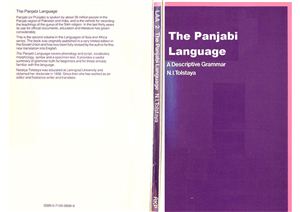Routledge Kegan & Paul, 1982. - 92 p.
Panjabi (or Punjabi) is spoken by about 35 million people in the Panjab region of Pakistan, and is the vehicle for recording the teachings of the gurus of the Sikh religion. In the last thirty years its use for official documents, education and literature has grown considerably.
This is the second volume in the Languages of Asia and Africa series. The book was originally published in a very limited edition in the Soviet Union and has now been fully revised by the author for this new translation into English.
The Panjabi Language covers phonology and script, vocabulary, morphology, syntax and a specimen text. It provides a useful summary of grammar both for beginners and for those already familiar with the language. Natalya Tolstaya was educated at Leningrad University and obtained her doctorate in 1956. Since then she has worked as an editor and freelance writer and translator.
Panjabi (or Punjabi) is spoken by about 35 million people in the Panjab region of Pakistan, and is the vehicle for recording the teachings of the gurus of the Sikh religion. In the last thirty years its use for official documents, education and literature has grown considerably.
This is the second volume in the Languages of Asia and Africa series. The book was originally published in a very limited edition in the Soviet Union and has now been fully revised by the author for this new translation into English.
The Panjabi Language covers phonology and script, vocabulary, morphology, syntax and a specimen text. It provides a useful summary of grammar both for beginners and for those already familiar with the language. Natalya Tolstaya was educated at Leningrad University and obtained her doctorate in 1956. Since then she has worked as an editor and freelance writer and translator.

